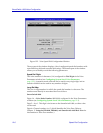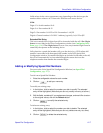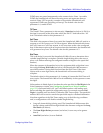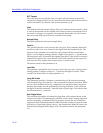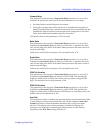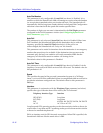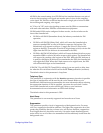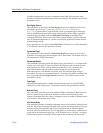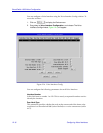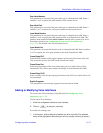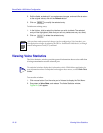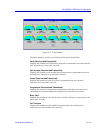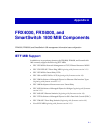
SmartSwitch 1800 Voice Configuration
12-14 Configuring Voice Ports
A higher suppression level saves composite bandwidth, allowing more data
channels to operate simultaneously with voice channels. The default value for this
parameter is low.
Ext. Digits Source
This parameter is relevant if the Dial Digits parameter conÞgured in the Voice
Parameters window (see ConÞguring System-Level Voice Parameters,
page 12-2) is greater than 0. It speciÞes the source of extended digits when the
user of attached equipment dials a speed-dial number. When Map is speciÞed,
extended digits are taken from the Extended Dial String in the Speed Dial
ConÞguration Table. When User is speciÞed, extended digits are taken from the
user of attached equipment (i.e., the user must dial a speed-dial number and an
extended digit string).
If you specify User, you must set the Dial Timer (see above) to a value other than
0. The default value for this parameter is Map.
Forwarded Type
This parameter is relevant only if Forwarded Digits (see below) is set to All or
Extended. It speciÞes how the dial digits will be forwarded. The default value for
this parameter is DTMF (dual-tone).
Forwarded Digits
This parameter speciÞes which dial digits (if any) to forward (i.e., to output at the
remote voice/fax card). If None is selected, dial digits are not forwarded to the
destination device when a call is initiated on this port. If All is selected, the
speed-dial number and associated extended digits are forwarded to the
destination device. If Extended is selected, only the extended digit string is
forwarded. The source of extended digits (i.e., from the map table or dialed by the
user) is speciÞed by Ext. Digits Source (see above). The default value for this
parameter is None.
Tone Type
This parameter determines whether the multi-frequency tone will be DTMF
(dual-tone) or MF (single-tone). The default value for this parameter is DTMF.
Blocked Flag
This value will cause the port to be enabled (if No) or disabled (if Yes) when the
device is powered up or rebooted. Whichever state is selected, the port will
remain in that state until this value is changed or until an enable or disable action
is performed. The default value is No.
Link Down Busy
This parameter enables or disables automatic busy-out of channels when the link
is down. When this parameter is enabled, the system will automatically busy-out
channels when the composite link is down. When disabled, channels remain
on-hook when the link is down. If your application is connected to a PBX that can
route calls to an alternate source (e.g., an ACD) based on an Òall busyÓ condition,
enable this parameter so the PBX will recognize this condition and reroute the



